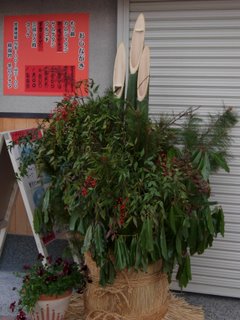

 The topmost photo shows a typical New Year's decoration hanging before the street door of a private residence. The straw rope is a shimekazari, the decorative form of the emblematic shimenawa. The latter is the thick rope which hangs from the torii, or gate, at the entrance to a Shinto shrine. The shimenawa is by some believed to represent the rope, strung by the gods across the entrance to the sun-goddess Amaterasu's cave, employed to prevent her return thereto, after she had been enticed to leave her lair. Alternatively, still others aver that the shimenawa represents the rope with which the gods, having abandoned diplomacy, hauled Amaterasu from her cave by main force. In any case, the straw tufts depending from both the shimekazari and shimenawa are the "roots" that, in the legend, still clung to the leaves and stems forming the straw rope. The white paper pendents, or gohei, are said to recall the ancient custom of making offerings of cloth to the gods. The remaining photos show the traditional New Year's decoration known as the kadomatsu. The kadomatsu, or" gate-pine", is placed outside public buildings and some commercial establishments. The components of the "gate-pine" are not merely decorative but symbolic as well. The lengths of bamboo forming the kadomatsu are cut to show their joints, or nodes. These are called setsu in Japanese. But homophonic to this is another setsu, meaning "fidelity, constancy". Thus, the bamboo serves to satisfy the Japanese love of word play, as well as to symbolize a highly prized virtue. The "pine" of the kadomatsu is likewise representative. Pines are symbols of strength and tenacity, for when other sylvan species lose their foliage, evergreens such as the pine retain theirs. The glossy green leaves, of which the larger kadomatsu contains an abundance, are yuzuri-no-ha, or leaves of the yuzuri. These are emblematic of the continuation of the family line from father to son in perpetuity, inasmuch as the dying leaves of the yuzuri do not fall off before their replacements have reached maturity. The straw wreath sometimes affixed to the kadomatsu is the wajime. As well as adding to the decoration of the kadomatsu, wajime may be found on automobile grilles and the doors of small businesses and residential properties. Not pictured is the variety of bitter orange named daidai. This edible decoration, seving to garnish trays of the traditional New Year's cuisine known as osechi, provides yet another example of the Japanese penchant for puns. The character 代、pronounced dai and meaning generation (among other things), when repeated becomes "from generation to generation," hence the symbolic significance of the bitter orange, the daidai.
The topmost photo shows a typical New Year's decoration hanging before the street door of a private residence. The straw rope is a shimekazari, the decorative form of the emblematic shimenawa. The latter is the thick rope which hangs from the torii, or gate, at the entrance to a Shinto shrine. The shimenawa is by some believed to represent the rope, strung by the gods across the entrance to the sun-goddess Amaterasu's cave, employed to prevent her return thereto, after she had been enticed to leave her lair. Alternatively, still others aver that the shimenawa represents the rope with which the gods, having abandoned diplomacy, hauled Amaterasu from her cave by main force. In any case, the straw tufts depending from both the shimekazari and shimenawa are the "roots" that, in the legend, still clung to the leaves and stems forming the straw rope. The white paper pendents, or gohei, are said to recall the ancient custom of making offerings of cloth to the gods. The remaining photos show the traditional New Year's decoration known as the kadomatsu. The kadomatsu, or" gate-pine", is placed outside public buildings and some commercial establishments. The components of the "gate-pine" are not merely decorative but symbolic as well. The lengths of bamboo forming the kadomatsu are cut to show their joints, or nodes. These are called setsu in Japanese. But homophonic to this is another setsu, meaning "fidelity, constancy". Thus, the bamboo serves to satisfy the Japanese love of word play, as well as to symbolize a highly prized virtue. The "pine" of the kadomatsu is likewise representative. Pines are symbols of strength and tenacity, for when other sylvan species lose their foliage, evergreens such as the pine retain theirs. The glossy green leaves, of which the larger kadomatsu contains an abundance, are yuzuri-no-ha, or leaves of the yuzuri. These are emblematic of the continuation of the family line from father to son in perpetuity, inasmuch as the dying leaves of the yuzuri do not fall off before their replacements have reached maturity. The straw wreath sometimes affixed to the kadomatsu is the wajime. As well as adding to the decoration of the kadomatsu, wajime may be found on automobile grilles and the doors of small businesses and residential properties. Not pictured is the variety of bitter orange named daidai. This edible decoration, seving to garnish trays of the traditional New Year's cuisine known as osechi, provides yet another example of the Japanese penchant for puns. The character 代、pronounced dai and meaning generation (among other things), when repeated becomes "from generation to generation," hence the symbolic significance of the bitter orange, the daidai.





4 comments:
good info. I appreciate knowing the symbolic meanings and word plays behind the new years decor.
japanglimpsed.blogspot.com is very informative. The article is very professionally written. I enjoy reading japanglimpsed.blogspot.com every day.
payday loan
loans
Very Interesting Blog! Thank You For Thi Blog!
Stunning quest there. What occurred after? Take care!
Also visit my site; www
Post a Comment